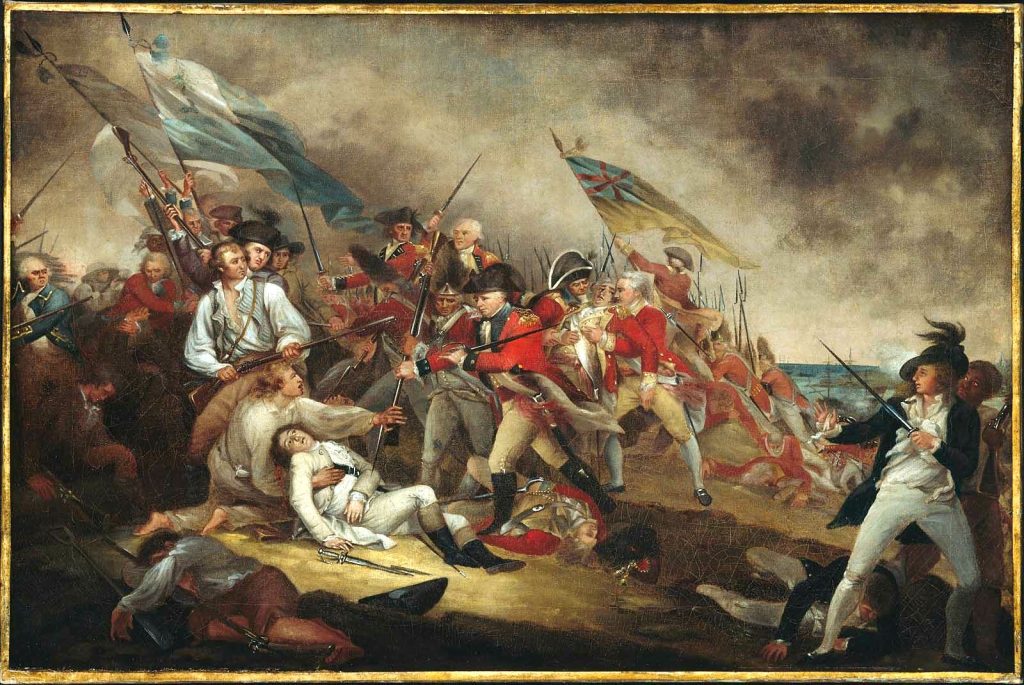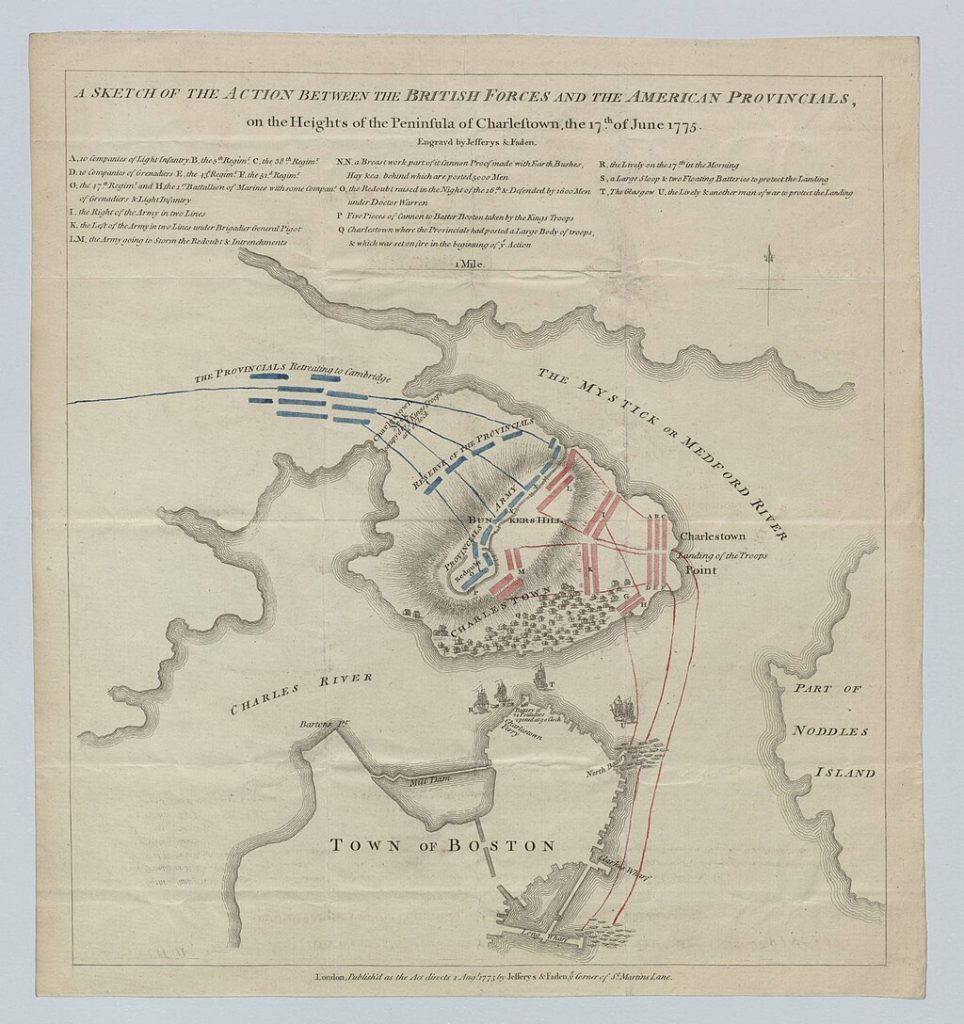Contents
Contents
The Battle of Bunker Hill was one of the early major conflicts of the American Revolution, fought on June 17, 1775, in Charlestown, Massachusetts.
The British Army won the battle, but the American Patriots put up a strong fight, proving that the colonial militias were a force to be reckoned with.

Summary
Leadup
After American victory at the Battles of Lexington and Concord on April 19, 1775, British forces retreated to Boston, Massachusetts.
As a port city, Boston was a key stronghold, but due to British naval superiority at the time, it was a difficult location for the Patriots to attack.
To put pressure on British forces and their supply lines, approximately 20,000 Patriot soldiers attempted to surround Boston.
By June, most of the forces were in place, but Charlestown, a small peninsula to the north of the city, was left unoccupied by either side.
In the middle of that month, the Patriots received intelligence that the British, under the command of Thomas Gage, planned to occupy the Charlestown peninsula. This intelligence was correct, but Gage first planned on occupying Dorchester Heights, to the south, to protect Boston from potential siege by artillery fire.
The Patriots immediately made plans to reach and fortify Charlestown before the British arrived. 1,000 militiamen under the command of General Israel Putnam and Colonel William Prescott were ordered to build fortifications on Bunker Hill, Charlestown, and they reached the peninsula on June 16th.
However, Prescott and his men mistakenly built their fortifications on Breed’s Hill, which is south of Bunker Hill, and in easier reach of British artillery fire.
The battle
As the sun rose on June 17, British ships in Boston Harbor noticed the newly built fortifications, and began firing on the colonial forces.
However, the ships had difficulty aiming, and the cannons did little to affect the fort, though the artillery fire caused minor damage and a handful of casualties.
The British met to discuss their options, and in the afternoon, sent approximately 2,300 troops to land on the peninsula from Boston, under the command of General William Howe.

Despite being outnumbered, occupying a relatively weak position, and being defended only by hastily built dirt forts (known as redoubts), the Patriots put up a valiant fight, inflicting heavy casualties on the British.
The British also faced a number of challenges related to the terrain of the peninsula:
- They had to wait to land their troops at high tide, limiting their tactical options. When the tide fell again, this made it difficult for ships to fire on Breed’s Hill and provide cover for the troops.
- British forces had to march up steep, muddy terrain, covered in tall grass and hay. While they were trying to climb the slope, Patriot forces fired down volleys of musket fire on the British troops.
- Carrying large amounts of gear, and wearing wool uniforms on a hot summer’s day, many British soldiers suffered from heat exhaustion.
The colonists repelled two waves of British attacks before running out of ammunition. On the third assault, the British took the fort, and outnumbered, the Patriots retreated back to Bunker Hill, before eventually leaving the peninsula.
In total, the British suffered 1,054 casualties, compared to 450 Americans killed/injured.
Significance of the Battle of Bunker Hill
The Battle of Bunker Hill proved to both the British and Patriot forces that the Revolutionary War would be a much closer-fought conflict than many originally realized.
Prior to the battle, many military leaders, especially on the British side, thought that the Redcoats would win the war easily, thanks to their greater levels of organization, manpower, and supplies such as gunpowder.
In contrast to the regimented, drilled appearance of the British Army, with their striking bright red uniforms, the Patriot forces at the time were effectively a ragtag militia.
Therefore, despite losing the Battles of Lexington and Concord, the British believed that they would put down colonial resistance relatively easily. Some thought that the colonist forces would simply scatter and disintegrate when met head-on by the British army.
However, the Battle of Bunker Hill showed that the Patriot forces, cobbled together from across the New England colonies, were more determined, resourceful, and coordinated than many expected.
When news of the number of casualties on both sides spread throughout the colonies, this led to a noticeable surge in Patriot morale. George Washington, who had just been appointed commander-in-chief of the Continental Army on June 15th, was said to be spurred on by the result.
On the British side, political and military leaders were concerned by the number of casualties that the army had suffered at the hands of the Patriots, labeling it a “dear-bought victory.”
Although the British were surprised at the result of the battle, they were not deterred by the number of killed and wounded. Instead, the Battle of Bunker Hill hardened British resolve to suppress colonial rebellion, and led to a more hardline anti-Patriot stance from the King and members of Parliament.
King George III officially labeled the colonies in open rebellion in August 1775, and the British Parliament officially rejected the Olive Branch Petition.
This, in turn, caused more colonists to lose respect for the British government and abandon hopes of reconciliation, leading to increased support for the Patriot cause.
Facts about the Battle of Bunker Hill
- The battle is named after Bunker Hill, which was located close to the fighting in Charlestown, Massachusetts. However, the battle was actually fought over Breed’s Hill, located just to the south, at a slightly lower elevation. These days, the area is simply known as Bunker Hill.
- Though they won the battle, the British suffered more than twice as many casualties as the Americans at the Battle of Bunker Hill.
- After the first British assault on the Charlestown peninsula, the Battle of Bunker Hill lasted approximately two hours.
- The town of Charlestown, which was occupied by civilians at the time, was completely destroyed during the battle as a result of British artillery fire.
- The famous Revolutionary quote “…don’t one of you fire until you see the whites of their eyes” is often attributed to Israel Putnam, a Continental General, at the Battle of Bunker Hill. Putnam’s orders are the result of ammunition shortages the Patriots faced during the battle. The militiamen were running very low on musket balls, and due to being so heavily outnumbered, the soldiers needed to ensure that every one of their shots hit their target.
- Of the British casualties, around 100 of their losses were officers as opposed to regular soldiers, further worsening the impact of the casualties suffered.
- The Bunker Hill Flag is named after the Battle of Bunker Hill. Revolutionary War artist John Trumbull claims that the flag was flown at the battle, though this is disputed by some historians.
- Joseph Warren was a Patriot General and Founding Father who died at the Battle of Bunker Hill. He decided to fight alongside his troops rather than acting as a general, and his death further galvanized Patriot resolve to resist the British. His death is immortalized in a painting by John Trumbull.

